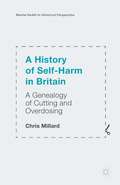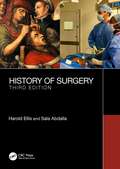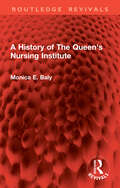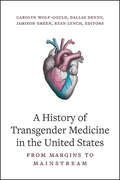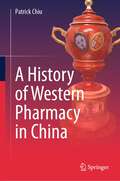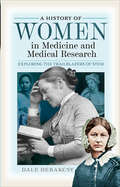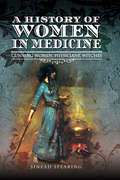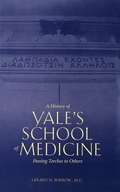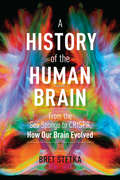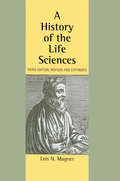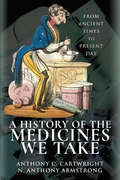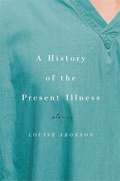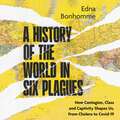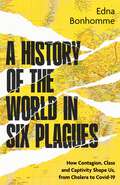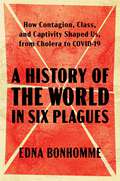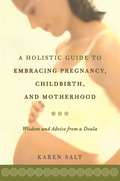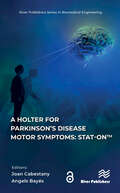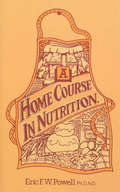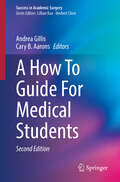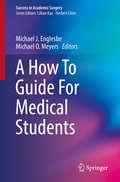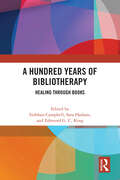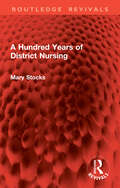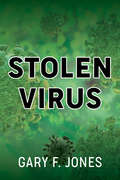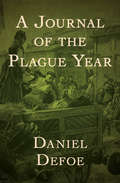- Table View
- List View
A History of Self-Harm in Britain: A Genealogy of Cutting and Overdosing (Mental Health in Historical Perspective)
by Chris MillardThis book is open access under a CC BY license and charts the rise and fall of various self-harming behaviours in twentieth-century Britain. It puts self-cutting and overdosing into historical perspective, linking them to the huge changes that occur in mental and physical healthcare, social work and wider politics.
A History of Surgery: Third Edition
by Harold Ellis Sala AbdallaWritten in a personal and engaging style, by a medical author and teacher of great renown, this book provides a fascinating and informative introduction to the development of surgery through the ages. It describes the key advances in surgery through the ages, from primitive techniques such as trepanning, some of the gruesome but occasionally successful methods employed by the ancient civilisations, the increasingly sophisticated techniques of the Greeks and Romans, the advances of the Dark Ages and the Renaissance and on to the early pioneers of anaesthesia and antisepsis such as Morton, Lister and Pasteur. Fully illustrated in colour, Ellis's History of Surgery is the only serious choice for a reader wanting a lively and informative single-volume introduction to surgical history.
A History of The Queen's Nursing Institute (Routledge Revivals)
by Monica E. BalyOriginally published in 1987, reissued here with a new preface, this book presented a history of the Queen’s Nursing Institute on the occasion of the centenary of its founding in 1887. Since that time, the Institute had been the major force behind all developments in the field of district nursing. Monica Baly here traces the history of the Institute concentrating not just on top personalities, but on showing what district nurses actually did and on relating developments to the social, political and cultural events and attitudes of the day. Breaking much new ground, the book should be essential reading for all district nurses in particular, and for other nurses and historians with an interest in the history of nursing. Still going strong today, now The Queen’s Institute of Community Nursing is a registered charity dedicated to improving the nursing care of people in the home and community.
A History of Transgender Medicine in the United States: From Margins to Mainstream
by Carolyn Wolf-Gould; Dallas Denny; Jamison Green; Kyan LynchThe most comprehensive history of transgender medicine to date, as told by more than forty scholars, physicians, psychologists, and activists from trans, gender-diverse, and allied medical communities.Arriving at a critical moment in the struggle for transgender rights, A History of Transgender Medicine in the United States takes an empathic approach to an embattled subject. Sweeping in scope and deeply personal in nature, this groundbreaking volume traces the development of transgender medicine across three centuries-centering the voices of transgender individuals, debunking myths about gender-affirming care, and empowering readers to grasp the complexities of this evolving field. More than forty contributors-including patients, advocates, physicians, psychologists, and scholars-weave an illuminating, sometimes surprising narrative of collaboration and conflict between trans people and the scientists who have studied and worked with them. An indispensable guide to understanding the current tumult surrounding trans health-care access in the United States, the volume underscores a crucial message: gender diversity is not a new phenomenon but an integral part of our shared human history.
A History of Western Pharmacy in China
by Patrick Chiu“This book represents an important contribution to the field as it is the first to provide a detailed account of the interaction between Chinese and western medicine from a pharmacy perspective over a period of two millennia with an emphasis on the modern period from 1800-1949. None of the existing historiography on the relationship between TCM and western medicine has so far explored pharmaceutical aspects in detail. This book therefore fills an important gap in the literature and is likely to become a key resource for further study. It will be of interest to a wide audience, including pharmaceutical, imperial, and business historians, and should be essential reading for pharmacy students. But it will also be of interest to a general readership curious about the history of pharmacy in China and of western influences on Chinese medicine. Stuart Anderson, BSc, MA, PhD, FRPharmS Editor-in-Chef, Pharmaceutical Historian, Emeritus Professor of Pharmacy History, London School of Hygiene & Tropical Medicine “Readers of this book, to Chiu’s credit, will be exposed to the nuanced cultural, medico-scientific, and business interactions that shaped Western pharmacy in China. Chiu puts a spotlight on the various materials, techniques, and processes of drug formulation and mass manufacture – and he rightly illustrates how pharmacy was substantiated as big business and mass manufacture. In analyses that incorporate materia medica and so-called dangerous drugs, such as opium, Chiu also articulates the complicated entangled histories of the movement, circulation, and translation of both pharmacy knowledge and goods. Yet, he appropriately acknowledges and evaluates non-Western epistemologies and practices that intermingled with Western ideas to create a novel type of pharmacy and pharmaceutical industry in China. Lucas Richert, PhD Professor & George Urdang Chair in Pharmacy History, UW-Madison Executive Director, American Institute of the History of Pharmacy”Patrick Chiu's book, A History of Western Pharmacy in China, effectively presents an unbiased perspective when discussing the contributions of expatriate pharmacy academics towards the development of China's pharmaceutical profession and the modern drug industry in the first half of the twentieth century. Chiu's impartial approach and well-researched content make it a recommended resource for understanding the historical development of pharmacy in China. Kazushige Morimoto Ph.D. D.Min, Education System - Qualified Pharmacist, President, The Japanese Society for the History of Pharmacy
A History of Women in Medicine and Medical Research: Exploring the Trailblazers of STEM
by Dale DeBakcsyIn the nineteenth century, a small but dedicated group of European and American women rose to agitate for the inclusion of women in the medical profession. It is a historic tale that we have told and retold for decades, but it is far from where the story of women as physicians and healers begins. Stretching back into deepest antiquity, we possess accounts of women who were consulted by emperors and paupers alike for their medical expertise. They were surgeons, apothecaries, midwives, university lecturers, and medical researchers in correspondence with the most learned societies of their time. And then it all came crashing down. A History of Women in Medicine and Medical Research is the story of the women who participated in that early Golden Age, and of a medical establishment closing ranks against them so effectively that, by the early Victorian era, they not only were barred from practicing medicine, but from so much as stepping into a classroom where medical topics were being discussed. It is the story of that intrepid band of reformers and pioneers who built back the women's medical profession from the ashes and constructed a thriving new community of researchers and practitioners who within a century had retaken not only the ground that had been lost, but boldly advanced to levels of fame and achievement unimaginable to any previous era. Told through in-depth accounts of the lives of the pioneers and practitioners who built and rebuilt the women's medical movement, this title dives into the lives of not only legendary figures like Florence Nightingale, Gertrude Elion, Rosalyn Yalow, and Elizabeth Blackwell, but visits women the world over whose medical contributions broke down doors and advanced the cause of women's and world health, like the revolutionary medieval physician Trota of Salerno, the pioneering eighteenth century midwife and businesswoman Madame du Coudray, the microbiological research trailblazer Mary Putnam Jacobi, and the HIV researcher and world epidemic response coordinator Francoise Barre-Sinoussi. With over 140 stories spanning three millennia of global medicine, this book shines a light on the unknown heroes, towering discoveries, tragic missteps, and profound struggles that have accompanied the Rise, Fall, and Rebirth of the women's medical profession.
A History of Women in Medicine: Cunning Women, Physicians, Witches
by Sinéad SpearingA study of the female healers of centuries past, and how they went from respected to reviled. Witch is a powerful word with humble origins. Once used to describe an ancient British tribe known for its unique class of female physicians and priestesses, it grew into something grotesque, diabolical, and dangerous. A History of Women in Medicine reveals the untold story of forgotten female physicians, their lives, practices, and subsequent denomination as witches. Originally held in high esteem in their communities, these women used herbs and ancient psychological processes to relieve the suffering of their patients, often traveling long distances, moving from village to village. Their medical and spiritual knowledge blended the boundaries between physician and priest. These ancient healers were the antithesis of the witch figure of today; instead they were knowledgeable therapists commanding respect, gratitude, and high social status. In this pioneering work, Sinéad Spearing draws on current archeological evidence, literature, folklore, case studies, and original religious documentation to bring to life these forgotten healers. By doing so she also exposes the Church&’s efforts to demonize them in the eyes of the world, leading female healers to be labeled witches and persecuted in the ensuing hysteria known today as the European witch craze.
A History of Yale's School of Medicine: Passing Torches to Others
by Gerard N. BurrowThis is a story of the Yale University School of Medicine starting from its origin to its present.
A History of the Human Brain: From the Sea Sponge to CRISPR, How Our Brain Evolved
by Bret Stetka&“A History of the Human Brain is a unique, enlightening, and provocative account of the most significant question we can ask about ourselves.&” —Richard Wrangham, author of The Goodness Paradox Just 125,000 years ago, humanity was on a path to extinction, until a dramatic shift occurred. We used our mental abilities to navigate new terrain and changing climates. We hunted, foraged, tracked tides, shucked oysters—anything we could do to survive. Before long, our species had pulled itself back from the brink and was on more stable ground. What saved us? The human brain—and its evolutionary journey is unlike any other. In A History of the Human Brain, Bret Stetka takes us on this far-reaching journey, explaining exactly how our most mysterious organ developed. From the brain&’s improbable, watery beginnings to the marvel that sits in the head of Home sapiens today, Stetka covers an astonishing progression, even tackling future brainy frontiers such as epigenetics and CRISPR. Clearly and expertly told, this intriguing account is the story of who we are. By examining the history of the brain, we can begin to piece together what it truly means to be human.
A History of the Life Sciences, Revised and Expanded
by Lois N. MagnerA clear and concise survey of the major themes and theories embedded in the history of life science, this book covers the development and significance of scientific methodologies, the relationship between science and society, and the diverse ideologies and current paradigms affecting the evolution and progression of biological studies. The author d
A History of the Medicines We Take: From Ancient Times to Present Day
by Anthony C. Cartwright N Anthony ArmstrongA fascinating account of poultices, pills, and prescriptions over the centuries and how they’ve been developed and delivered.This lively account follows the development of medicines from traces of herbs found with the remains of Neanderthal man, to prescriptions written on clay tablets from Mesopotamia in the third millennium BC, to pure drugs extracted from plants in the nineteenth century, and to the latest biotechnology antibody products. In addition, it tells the stories behind historical figures in medicine, such as Christopher Wren, who gave the first intravenous injection in 1656, and William Brockedon, who invented the tablet in 1843, as well as recounting the changes in patterns of prescribing from simple dosage forms—such as liquid mixtures, pills, ointments, lotions, poultices, powders for treating wounds, inhalations, eye drops, enemas, pessaries, and suppositories mentioned in the Egyptian Ebers papyrus of 1550 BCE—to the complex tablets, injections, and inhalers in current use. A typical pharmacy now dispenses about as many prescriptions in a working day as a mid-nineteenth-century chemist did in a whole year. This history sheds light on the scientific progress made over centuries that led to the medical miracles of the modern world.
A History of the Present Illness: Stories
by Louise AronsonA History of the Present Illness: Stories takes readers into overlooked lives in the neighborhoods, hospitals, and nursing homes of San Francisco, offering a deeply humane and incisive portrait of health and illness in American today. An elderly Chinese immigrant sacrifices his demented wife's well-being to his son's authority. A busy Latina physician's eldest daughter's need for more attention has disastrous consequences. A young veteran's injuries become a metaphor for the rest of his life. A gay doctor learns very different lessons about family from his life and his work, and a psychiatrist who advocates for the underserved may herself be crazy. Together, these honest and compassionate stories introduce a striking new literary voice and provide a view of what it means to be a doctor and a patient unlike anything we've read before. In the tradition of Oliver Sacks and Abraham Verghese, Aronson's writing is based on personal experience and addresses topics of current social relevance. Masterfully told, A History of the Present Illness explores the role of stories in medicine and creates a world pulsating with life, speaking truths about what makes us human. A Reading Group Guide is included at the end of the book.
A History of the World in Six Plagues: How Contagion, Class and Captivity Shape Us, from Cholera to Covid-19
by Edna BonhommeA History of the World in Six Plagues unveils a powerful and unsettling truth: epidemic diseases enter the world by chance, but they become catastrophic by human design.In this groundbreaking work, Bonhomme explores how six pivotal diseases-Cholera, HIV/AIDS, the Spanish Flu, Sleeping Sickness, Ebola, and COVID-19-have shaped the trajectory of human history. With vivid storytelling and rigorous research, she reveals how pandemics have consistently widened the gaps in racial, economic, and sociopolitical divides, from the slave ships of the Atlantic to today's fractured healthcare systems.How did a colonial obsession with sugar amplify the devastation of Cholera? Why did sleeping sickness become a weapon of empire in Tanzania? And how has COVID-19 magnified inequities in our modern, interconnected world?Bonhomme's incisive analysis transforms our understanding of public health, not as a neutral force but as a stage where power, policy, and prejudice collide. Urgent and illuminating, A History of the World in Six Plagues is not just a history of disease - it is a call to reimagine a more equitable future in the face of ongoing global health challenges.'This book tells the accounts of people who deserved better. It is also a story of redemption, and of the little child in all of us, curled up alone in a huge bed, without her parents, who wants to be healthy and free.'
A History of the World in Six Plagues: How Contagion, Class and Captivity Shape Us, from Cholera to Covid-19
by Edna BonhommeA History of the World in Six Plagues unveils a powerful and unsettling truth: epidemic diseases enter the world by chance, but they become catastrophic by human design.In this groundbreaking work, Bonhomme explores how six pivotal diseases-Cholera, HIV/AIDS, the Spanish Flu, Sleeping Sickness, Ebola, and COVID-19-have shaped the trajectory of human history. With vivid storytelling and rigorous research, she reveals how pandemics have consistently widened the gaps in racial, economic, and sociopolitical divides, from the slave ships of the Atlantic to today's fractured healthcare systems.How did a colonial obsession with sugar amplify the devastation of Cholera? Why did sleeping sickness become a weapon of empire in Tanzania? And how has COVID-19 magnified inequities in our modern, interconnected world?Bonhomme's incisive analysis transforms our understanding of public health, not as a neutral force but as a stage where power, policy, and prejudice collide. Urgent and illuminating, A History of the World in Six Plagues is not just a history of disease - it is a call to reimagine a more equitable future in the face of ongoing global health challenges.'This book tells the accounts of people who deserved better. It is also a story of redemption, and of the little child in all of us, curled up alone in a huge bed, without her parents, who wants to be healthy and free.'
A History of the World in Six Plagues: How Contagion, Class, and Captivity Shaped Us, from Cholera to COVID-19
by Edna BonhommeA deeply reported, insightful, and literary account of humankind&’s battles with epidemic disease, and their outsized role in deepening inequality along racial, ethnic, class, and gender lines—in the vein of Medical Apartheid and Killing the Black Body.Epidemic diseases enter the world by chance, but they become catastrophic by human design. With clear-eyed research and lush prose, A History of the World in Six Plagues shows that throughout history, outbreaks of disease have been exacerbated by and gone on to further expand the racial, economic, and sociopolitical divides we allow to fester in times of good health. Princeton-trained historian Edna Bonhomme&’s examination of humanity&’s disastrous treatment of pandemic disease takes us across place and time from Port-au-Prince to Tanzania, and from plantation-era America to our modern COVID-19-scarred world to unravel shocking truths about the patterns of discrimination in the face of disease. Based on in-depth research and cultural analysis, Bonhomme explores Cholera, HIV/AIDS, the Spanish Flu, Sleeping Sickness, Ebola, and COVID-19 amidst the backdrop of unequal public policy. But much more than a remarkable history, A History of the World in Six Plagues is also a rising call for change.
A Holistic Approach to Organic Synthesis
by Philip GarnerSynthesis is one of the distinguishing features of chemistry as a science. It is the synthetic chemist who uses their intimate understanding of molecular structure and properties to produce materials of great value to society. Thus, it is important for students of chemistry to study synthesis and acquire a working knowledge that enables them to address the following question: given a specific molecular target, how does one formulate a plan for its synthesis? This synthesis primer provides students who have taken introductory organic chemistry with a set of tools that can be used to plan a synthesis. It may be used in conjunction with a synthetic methods course, or it can stand alone.Features: Provides students who have taken introductory organic chemistry with a set of tools that can be used to plan a synthesis Serves to help organic chemists at all levels to better understand published syntheses Focuses on natural products, their complexity, and diverse structures which challenge and inspire the chemists preparing them Succinct, readable treatment of important concepts and applications geared towards advanced undergraduates and graduate students Each synthesis covered begins with a brief discussion of the target molecule and challenges they present, followed by retrosynthetic considerations
A Holistic Guide to Embracing Pregnancy, Childbirth, and Motherhood: Wisdom and Advice from a Doula
by Karen SaltThe newly pregnant woman faces a multitude of changes in her mind, life, and body, some of which are addressed by traditional medical care but many of which are not. In this holistic guide, the expectant mother will find warm and reassuring advice that will help her stay calm, focused, and energized during this exciting time and beyond. Rather than treat the arrival of a baby as strictly a one-moment-in-time medical event, author Karen Salt provides advice and wisdom to "treat" the whole woman-her emotions and her physical changes-and covers the entire year-long experience of pregnancy, childbirth, and the postpartum period. Salt's holistic approach unveils for mothers-to-be the backbone of the doula role-to provide support, information, advocacy, and facilitation to women during pregnancy, labor, and early motherhood-and teaches her the many ways to use the doula philosophy to nurture herself through the process. From meditation and relaxation exercises, to fitness and nutrition advice to tips for achieving "positive energy living," this comprehensive guide puts mothers in control of their pregnancy, their birthing experience, and their approach to this wonderful and life-altering time.
A Holter for Parkinson’s Disease Motor Symptoms: STAT-On™ (River Publishers Series in Biotechnology and Medical Research)
by Joan Cabestany Angels BayésA new information and communication technology (ICT) has been deployed in the battle against Parkinson’s disease, a neurodegenerative disorder that is both progressive and disabling with significant impact on quality of life. This book explains the experience following from the achieved results in the REMPARK project on Parkinson’s disease management up to the launch of a new medical product to the European market, STAT-ON™. The new medical device, STAT-ON™ is a real Holter for the motor symptoms associated to PD. It provides objective information about the severity and distribution of PD motor symptoms and their fluctuations in daily life, allowing for an unbiased and correct monitoring of the patient. This real-time remote monitoring solution gives additional information to neurologists, opening up new possibilities for more effective treatment, more accurate control in clinical trials, and for early detection of motor complications. The number of PD patients is continuously rising, adding complexity, especially in the management at the level of public health. It is an incurable disease, with a symptomatic treatment that tries to alleviate the associated symptoms through a correct adjustment of the medication. For this reason, it is also very important to be aware of changes in the manifestation of the symptoms, which may indicate the need for an adjustment or even a change in the therapy strategy. The intensive complementary use of STAT-ON™ by neurologists, health professionals and researchers, will increase the independence and quality of life of patients, improving their disease management, and contributing to a deeper understanding of the nature of the disease.
A Home Course In Nutrition
by Eric F PowellThis book provides lessons in nutrition which are intended as a helpful and practical guide to proper feeding, and cover the whole of the necessary matters connected with the subject. Food on the mind has not been neglected.Readers who carry out the suggestions made to the best of their ability will add greatly to life and happiness. Read and apply, and results are assured.
A How To Guide For Medical Students (Success in Academic Surgery)
by Andrea Gillis Cary B. AaronsThis book will provide a guide for medical students to self-reflect, build a portfolio, and select a career path equipped with the knowledge to make an informed decision that is the best for them. The editors comprise a diverse spectrum from background, stage of training, type of practice, to career path. This is a timely update taking into account new situations such as the virtual environment for residency applications, the spotlight on residency wellness, and incorporating diversity, equity, and inclusion in our personal and institutional missions.
A How To Guide For Medical Students (Success in Academic Surgery)
by Michael J. Englesbe Michael O. MeyersThis book will be a 'how to' guide for medical students interested in pursuing a career in academic surgery. It will discuss personal traits and rationale for going into academic surgery. It will review accomplishments as a medical student that are key components of beginning an academic career and highlight what makes a student competitive for a surgical program. Sections will be devoted to mentorship, research experience and personal experiences that lead to success. The editors will also focus on gender and work-life balance issues that often are perceived as barriers to a career in academic surgery. It will also provide key dates and sample application information for students to use as templates.
A Hundred Years of Bibliotherapy: Healing through Books
byThe First World War gave new and vital impetus to the ancient idea that books could heal. This interdisciplinary collection provides a targeted survey of 100 years of historical and contemporary understandings and practices of ‘the book as cure’.The contributors explore the curative practices of wartime reading, how they were developed and institutionalized after the war, and the afterlives of these ideas and practices today. Divided into three sections, the first considers bibliotherapy in World War I.’ It is rooted in the wartime cultures which ensured bibliotherapy became part of the active treatment of soldiers’ damaged minds and bodies on both sides of the Atlantic after 1914. Parts two and three examine the expanding variety of critical contexts, both historical and more modern, in which reading and wellbeing continued to intersect. The chapters draw on a wide range of source material from trench magazines to autograph books to e-novels, as well as on data and information drawn from practice-based encounters. They also provide the basis for further scholarly exploration of, for example, national traditions and contexts and the inter-disciplinary relationships which they inspire.A Hundred Years of Bibliotherapy: Healing through Books provides the first interdisciplinary dialogue on and account of bibliotherapy, addressing both historical and present-day modes of engaging with the ostensibly curative power of reading and reading cultures. It is an invaluable resource for scholars of literary studies, book history, and the medical humanities.
A Hundred Years of District Nursing (Routledge Revivals)
by Mary StocksOriginally published in 1960, this is a graphic and humorous story of district nursing from its beginning, with the first nurse engaged to work in the slums of nineteenth-century Liverpool, up to the time of publication. Mrs Stocks records how ‘our nurse’ had been and still was a familiar and beloved figure in busy cities and remote rural areas throughout the United Kingdom and was rapidly assuming a similar position in many other parts of the world.William Rathbone of Liverpool early recognized the need for a central organization to recruit and train district nurses and became the father of the Queen Victoria Jubilee Institute for Nurses, or as it became, the Queen’s Institute of District Nursing (now Queen’s Institute of Nursing). The background of its formation gives a fascinating glimpse of different classes of Victorian England. Mrs Stocks describes how Queen Victoria, the Institute’s first Patron, conveyed her wishes to the ‘top people’ who devised and organized the service with the inflexible guidance of Florence Nightingale. At the other end of the scale, she tells of some of the appalling conditions found in the homes by the pioneer nurses. She describes how the Queen’s Institute grew from strength to strength in spite of buffeting by high political winds, until at the time it played an important part in preserving the nation’s health. Today it is a registered charity dedicated to improving the nursing care of people in the home and community.
A Jerk, a Jihad, and a Virus: A Novel
by Gary F. JonesVeterinary virologist Jason Mitchell can't keep his mouth shut, can't lie convincingly, and can't follow orders. He's an unlikely candidate to help the CIA locate and destroy a deadly hybrid virus stolen from Jason's lab at the University of Minnesota. From Washington to Djibouti, From Minneapolis to Yemen, Marines cringe, Senators turn livid, and CIA agents shudder as Jason struggles to prevent the virus from becoming a biological weapon in the hands of jihadists. Jason and Ann Hartman, veterinarians, lovers, and graduate students, conduct a study of BCV in calves, a common virus that causes diarrhea in cattle. A recently arrived Chinese student accidentally exposes the calves to the SARS virus, a close relative of BCV. The calves and the Chinese student develop a severe and puzzling pneumonia. The Center for Disease Control (CDC) isolates a hybrid BCV-SARS virus from the Chinese student and the calves. The FBI is notified of the new and dangerous virus. Ahmed, more con man than graduate student, discovers samples of Jason's that contain the virus. He steals them and flees to Yemen where he pretends to be a devout Muslim to get funding from a jihadist group. The jihadists believe the virus will be valuable as a biological weapon and as bait to lure the CIA into military action that will kill innocent civilians and increase hatred of the US. Jason and an unconventional CIA agent redefine "thinking outside the box" as they con Ahmed, dodge bullets, and thwart the jihadists.
A Journal of the Plague Year: Written By A Citizen Who Continued All The While In London...
by Daniel DefoeDefoe&’s gripping fictionalized account of the plague that racked seventeenth-century London The year is 1665 and the plague has come to London. The air is heavy with death, the body count is rising, and the death carts are filling quickly. Our unflinching eyewitness narrator, HF, recounts the gruesome realities of life in a city overrun by the Black Death. Terror and hysteria seize the city as disease runs rampant. Blending fiction with journalism, Defoe re-creates the plague in all its horrifying detail. First published in 1722, A Journal of the Plague Year is one of the most chilling accounts of the plague ever written. This ebook has been professionally proofread to ensure accuracy and readability on all devices.
